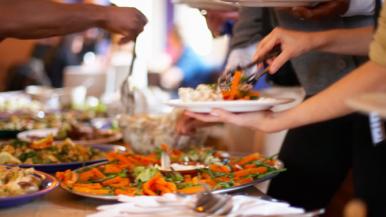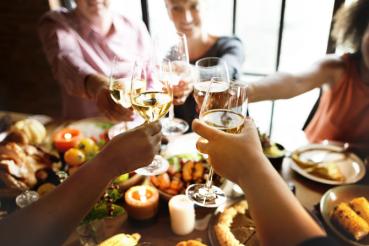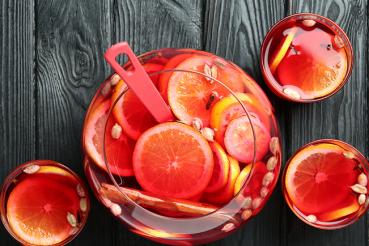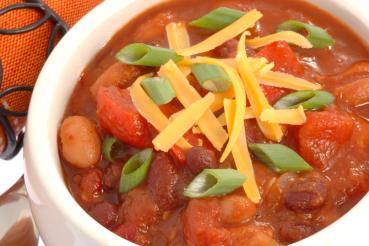Trying to lose weight during the holiday season may be unrealistic, given that the average American gains one to five pounds between Thanksgiving and New Year's Day, a six-week span marked by celebrations, eating and drinking.
This is especially true for people who are already overweight.
A review of studies evaluating holiday weight gain determined the average gain between Thanksgiving and New Year's to be only 0.8 pounds. However, people who were already overweight or obese gained as much as five pounds. A more recent evaluation also found that obese people experienced greater increases in body fat over the holiday season compared to people in the normal weight range.
So instead of dieting during the coming weeks, Rush dietitian Jennifer Ventrelle, MS, RD, CPT, suggests setting the more achievable goal of maintaining your weight throughout the holidays. You can then focus on shedding pounds once the hustle and bustle ends — and if you've maintained, you won't have extra weight to lose in January.
It may seem like a contradiction to be able to enjoy the holidays and maintain your weight, but it's not. Here, Ventrelle shares 10 tips to help you stay the course.
1. Move more.
One of the main reasons for holiday weight gain? Decreased physical activity. Because of our various food traditions and abundance of holiday treats, it's almost guaranteed we'll eat more. That means we need to move more simply to keep from putting on pounds.
The good news is that people who are more active are better able to keep their weight stable during the holidays. Try these simple cold-weather strategies:
- Bundle up and take a brisk walk outside — the cold air will also rejuvenate you. Make a post-meal walk a new family tradition so you can share the benefits and bond with loved ones.
- If you're at the mall doing your holiday shopping, take a few laps around the building before you start looking for gifts.
- Dance vigorously to your favorite holiday songs at home or at holiday parties.
2. Mind your beverages.
High-calorie drinks such as hot chocolate, flavored teas and eggnog are readily available during the holiday season. So are alcoholic beverages. These drinks are delicious, but the calories you drink, combined with all that food, can add up quickly.
Keep these numbers in mind when deciding how much to indulge at a holiday celebration:
- 1 cup of eggnog = 350 calories and a whopping 20 grams of fat
- 12 ounces of light beer = 55-110 calories
- 12 ounces of regular beer = 150-200 calories
- 8 ounces of rum and Diet Coke = 100 calories
- 8 ounces of rum and Coke = 250 calories
- 6 ounces of wine = 130 calories
- 6 ounces of sweet/dessert wine = 280 calories
Sipping on a glass of water in between holiday beverages will help you consume fewer of the high-calorie drinks. The water will also keep you hydrated, which is especially important if you're drinking alcohol.
And keep in mind that there are lots of liquid alternatives that aren't high in calories: for instance, club soda, mineral water or tomato juice with a twist of zesty fresh lime.
Eating something light shortly before the party will help keep you from stuffing yourself with treats once you arrive.
3. Balance your day.
Balance your caloric total for the day of a holiday get-together by eating small meals with fewer calories the day of a holiday event.
Opting for small meals during the day will not only keep you from eating too much at the party, it will also help keep your metabolism going, which naturally burns calories.
4. Never go to a party hungry.
You may be more likely to buy more when grocery shopping while hungry. The same is true for parties.
Eating something light shortly before the party will help keep you from stuffing yourself with treats once you arrive.
Thirty minutes before you go, drink a tall glass of water with fresh lemon or lime. Then, eat a snack that combines fiber and protein, such as half a peanut butter sandwich on whole grain bread, lowfat Greek yogurt, a fresh apple with a lowfat cheesestick, or baby carrots/cucumbers with hummus.
5. Make your first course light.
Instead of making a beeline for the cookies, cakes and pies when you get to the party, fill up your first plate with fresh vegetables. And wash them down with a glass of water — instead of soda or alcohol.
The veggies and water will both help you feel full. Why? The "stop eating" signal is sent to your brain in response to the weight and volume of food in your stomach. Vegetables and water are heavy and take up a lot of space while containing minimal calories.
Conversely, the refined sugars, salt and fats found in many holiday treats send signals to your brain to continue eating by triggering the brain's "pleasure centers."
Let the veggies and water tell your brain that you are full before you get "tricked" into eating all the goodies in sight.
6. Enjoy your meal at a leisurely pace.
Eating slowly and waiting five to 10 minutes before refilling your plate can also help you avoid overeating.
The reason: It takes 20 minutes for your brain to recognize that the stomach is full. So if you take your time at a meal, you're less likely to keep eating beyond the point where you're actually full.
7. Don't be 'the host with the most.'
If you're hosting a party, don't get stuck with lots of leftover food you feel obligated to eat. Instead, set up a "carry out station" with to-go containers and baggies for people to take leftovers with them. Or walk around with food trays and offer your guests seconds — and extras to bring home.
If you're contributing to the party, bring a healthy dish. Experiment with different lowfat recipes or try one of the following:
- Fresh fruit platter with low-fat yogurt
- Veggie platter with low-fat dip or hummus
- Baked chips with salsa or guacamole
8. Trim the fat and calories from holiday meals.
Make your holiday recipes healthier with these simple swaps:
- Steam, bake or broil foods instead of frying them
- Cook vegetables and other foods in broth instead of oil
- Use skim or 1 percent cow's milk, or unsweetened almond, coconut or cashew milk instead of whole milk
- Replace half of the fat contributors — such as butter or oil — with applesauce
- Use two large egg whites for each whole egg
- Replace half of the white flour with whole wheat flour or almond flour in baked goods
- Double up on vanilla extract, cinnamon or nutmeg to enhance flavor
9. Be mindful of portion sizes.
It's not just what you eat, it's how much you eat that matters. You can enjoy your favorite high-calorie foods, just eat less of them.
Whether you're hosting a party or bringing food, make each portion of your dish smaller. For instance, cut a pie into 12 pieces instead of 8, or create 48 brownies per pan instead of 24. Make a batch of cake pops or mini cupcakes instead of a large cake or full-sized cupcakes. And try serving pudding or mousse in shot glasses instead of large bowls.
Tiny treats are fun to eat and pack fewer calories. Plus, your fellow guests can try more of a variety of dishes.
10. Don't let your indulgences snowball.
Even if you wind up eating and drinking more than usual during a celebration, don't let it become a habit for the entire season.
The actual holidays are really only three to eight individual days. Eating unhealthy foods on the holidays alone won't cause too much damage, especially if you stay active. But if you expand those specific days into six weeks of nonstop eating and drinking, there's a good chance you'll also expand your waistline.
Finally, don't beat yourself up about indulging in your favorite goodies. Enjoying and treating yourself is part of what the holidays are all about. Tomorrow is another day — and another chance to focus on healthy behaviors.




